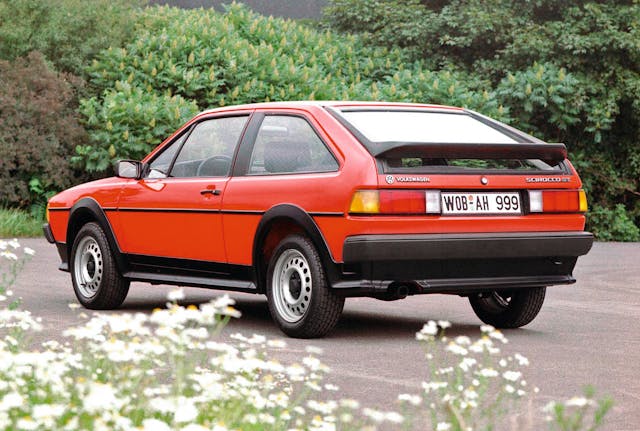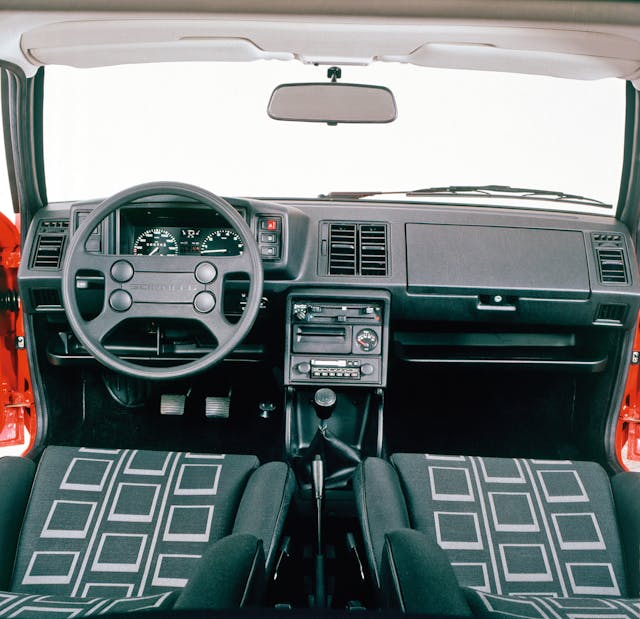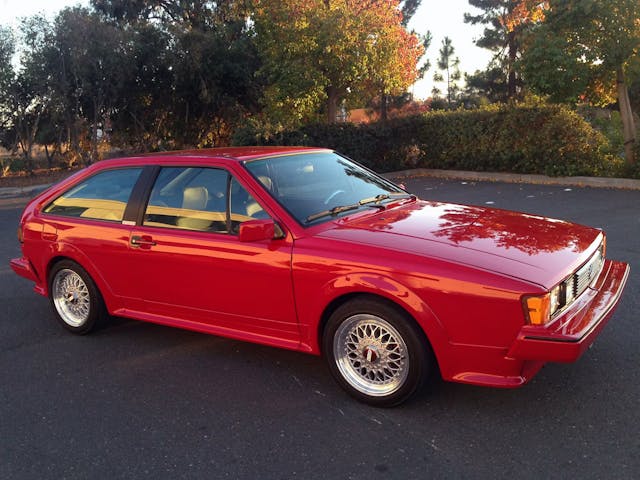Volkswagen’s Mk II Scirocco Is on a Hot Streak
Thirty-five or so years ago, I would ride my BMX bike around our neighborhood in McLean, Virginia, to check in on the cars I thought were cool. My loop took me past an old Datsun Z-car, then a pale yellow early ’50s Cadillac, and a late ’60s Mustang in pretty rough shape. One day, a car unlike anything my young eyes had yet seen caught my eye and I had to stop.
It looked fast, all wedge-shaped and hunkered down. But what was this—a Volkswagen? I set my bike down and walked to the back of the car. I read the block letters aloud, “Ski-Rock-Oh 16V,” and immediately assumed I said it wrong, though I had no idea what the right way would be. The name sounded about as odd to me as the idea that Volkswagen would make a car that appeared so sporty.
Grade-school me didn’t know a lot of things, including that the Scirocco (shi-rock-oh) had been around for more than a decade, and that the second-generation car had just ceased to be sold in the U.S. Now, marginally more knowledgeable, I recognize the MkII Scirocco as the more slickly designed front-wheel-drive platform-mate to the ubiquitous Golf and appreciate its fun, tossable nature. Based on Hagerty Price Guide values for the Mk II, along with an increase in quotes sought for the model, it appears other enthusiasts have taken note, too.
The Mk II Scirocco debuted in the U.S. in 1982, replacing the Guigiaro-designed original with a model that was penned in-house (though many point to the clear influence of an earlier Guigiaro concept, the Asso di Picche, or “Ace of Diamonds, in the Mk II’s looks). In addition to updating the original’s ’70s wedge looks for a new decade, the new model further optimized space within the car and continued to carry the sporty flag for Volkswagen.

By the mid-’80s, however, the term “sporty” might well have deserved a set of quotes around it, as the 90-horse 1.8-liter four was beginning to look weak in the face of other marques emerging from a malaise-era power slumber. Still, the car was an engaging momentum machine with crisp handling that impressed contemporary reviewers.
To remedy the power deficiency, VW introduced the Scirocco 16V in mid-1986 with a twin-cam, 16-valve 1.8-liter engine producing 123 horsepower. “Bring on your valiant V-6, your twin-cam, multivalve whiz-bang, your turbo tornado. This VW—the fastest and most powerful machine ever to wear those initials in America—is ready for all comers,” beamed Csaba Csere in the August 1986 issue of Car and Driver.
The 16V truly was the Mk II to have. Along with the updated engine, the car also received larger brakes up front, and discs replaced the drums in the rear. The suspension got the usual heavy-duty tricks, with stiffer springs and shocks and slightly larger sway bars. The body got additional stiffening elements, and gear ratios in the transmission were changed to complement the added power of the engine. It was the ultimate iteration of the Scirocco that would be seen stateside.
It wouldn’t be stateside for long, however. The Scirocco was done in the U.S. after 1988, the year the all-new Corrado debuted, though the older car would soldier on in other markets till 1992.

I didn’t see many more Sciroccos besides that one in my neighborhood, at least until I started SCCA club racing in 2006. There are always several VWs in the paddock on a given race weekend, and though most are Golfs or the odd Jetta running in Improved Touring, there’s usually a Scirocco or two still running in the production classes. That they’re popular as race cars makes sense—the A1 platform these cars share, even when stock, is entertaining, precise, and responsive. They’re also relatively straightforward to work on and don’t suffer from the overcomplication found in some more modern German machinery.
The last five years have treated Mk II Sciroccos exceptionally well. Values for the best cars have exploded from just under $13,000 in 2019 to a full 60 grand in the latest edition of the Hagerty Price Guide. #2 (Excellent) condition cars are still a pretty penny at just under $40K. Fortunately, although driver-quality cars (#3 and #4 condition) have also blossomed in value, you can still find them between $10K and $20K. Naturally, the 16V cars command a premium over those with lesser engines.
What’s behind this bump? Mk II Sciroccos didn’t sell all that well in the States when new, and just under 300,000 were made worldwide—paling in comparison to the 6.3 million VW Golfs that were pumped out of factories in seven different countries. (Values for the Mk II Golf, in comparison, are about half of the Scirocco’s.) Rust has claimed more than a few Sciroccos over the years, and many also met an early end, as is often the case with cars that spend decades living in the overlap between cheap and fun. Add in the thirst for cars from the ’80s, and those Sciroccos that are still around have a pretty captive audience.

Quote count for those seeking insurance remains relatively low, but it did spike 56 percent from 2022 to 2023. The average quoted value of that group was just under $14,500, squarely between #3 (Good) and #4 (Fair) condition. Gen X and millennials are the two generations showing the strongest growth in policy counts, though baby boomers, while their share is slipping, retain nearly a quarter of Mk II Scirocco policies with Hagerty.
Given the strong values, increase in quote count, and solid interest from enthusiasts who might have first experienced them as 10-to-15-year-old used cars, the collector outlook for Sciroccos is pretty healthy. They might not be as cheap as they once were, but as a confluence of sleek design, a tossable front-wheel-drive platform, and easy maintenance, a driver-quality MkII Scirocco checks a lot of boxes for a collector car you can use.
***
Want a better understanding of what’s driving collector car values? Sign up for the Hagerty Insider newsletter.



Nice car. Not many left and good examples will be of value. Model Specific parts could be very difficult to locate.
If you want one get the best you can find it will save you money.
One of the neatest cars I ever owned from new was a 1980 Gen I Scirocco. The styling is still, to my mind, a classic. Finally sold it after six years because the Blaupunkt AM/FM cassette stereo system kept getting stolen. Solved the stereo problem, though, by replacing with a basic AM/FM radio. With a/c and wind up windows it had everything needed as a daily driver and long distance cruiser.
Likewise; I had two 80 Sciroccos. LOVED the first, the second had some issues. Each was distinctive, and handled excellently given the front drive layout.
I’d read that the German Golf GTIs were wonderful, but they weren’t in the States back then.
I eventually worked for Sony USA, which purchased the former US VW plant in SW PA. On walks I could still see the test-track bobbles. I thought it cool.
I always liked Gen I over Gen II. Simplicity.
These cars handled well.
They were great cars, fun to drive. The Corrado was a good looking successor.
My first brand new car was a 1986 1/2 VW Scirocco 16V. I owned used Rabbits prior to that and they were cheap to buy, run and maintain back in my college years. I would not consider them all that fast compared to my 1970 Chevelle SS454 (sold it for college money – one of my bigger mistakes with cars) but the VWs could drive and handle well with some mods. I was lucky to have a great race shop Shine Racing Services that knew how to set these up for street and track. I would later buy the Rocco replacement Corrado with the VR6 but I kept the Rocco and I would autocross and track it when I had a chance and was still registered for the street. Replaced the springs with race springs (very firm but not harsh), Boge tubo gas shocks/struts, took off the front sway bar (the stiffer springs stopped the lean in turns), put on the SRS massive rear sway bar kit, a must have Quaife limited slip differential that greatly reduced torque steer, many other mods to numerous to list and it was far more neutral and better handling than stock. It was a fun car for the it’s time.
Never cared for the blander styling of the 2nd-gen Scirocco. Maybe they just should have moved straight from Gen-1 to the Corrado.
Agree; I like Gen 1 over the second.
which hagerty writer did Cammisa have to threaten to write this article?
In 1982 I needed a reliable new car for my work. I went to the Honda dealer intending to purchase a 2 door accord. I wanted a sunroof and optional alloy rims.
The salesman laughed at me and said no way, and not only that, there was a “Market Adjustment” add on price of $1500., plus upcharges for paint protection, interior protection treatment and rust proofing, above the list price.
Purchased a Scirocco instead. Alloy wheels, sunroof, better interior, and a $1000. less expensive. Never a problem, awesome in snow/ice, never looked back. And never in a Honda showroom again.